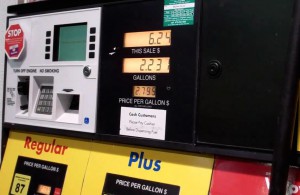
Canadian forest fires have cut exports of crude oil to the U.S., causing gas prices to rise to their highest average this year.
Gas prices are at their highest point for the year with the biggest jump in prices coming in the upper Midwest where the forest fires in the Canadian Tar Sand Region have crippled exports of crude oil to Midwestern refineries.
AAA noted in its weekly report on fuel prices that with the approach the Memorial Day holiday, the national average has increased for 12 days in a row an average of $2.28 per gallon is up six cents per gallon on the week and 15 cents per gallon on the month.
The nation’s top five most expensive markets are: California at $2.80 per gallon, Hawaii at $2.66 per gallon, Washington at $2.59 per gallon, Alaska at $2.58 and Nevada at $2.49. In addition, for the first time since August 2015, drivers in every state and Washington, D.C. are paying averages above $2 per gallon, according to AAA.
The least expensive markets are Mississippi at $2.05 per gallon, South Carolina at $2.06 per gallon, Arkansas at $2.06, Texas at $2.07 and Missouri at $2.07, AAA reported.
However, regional gasoline inventories decreased for the 14th consecutive week.
AAA said interruptions in crude oil deliveries to refineries in the Midwest, due to fires in the Canadian Oil Sands, have hampered the ability of refineries in the Midwest to meet growing demand for fuel. Pump prices continue to swing in the region and the Midwestern states of Ohio where gasoline has climbed and Michigan where prices are up 13 cents per gallon and Indiana where prices increased by 11 cents per gallon posted the largest week-over-week increases in the price of gas.
During the past month, Minnesota where prices up 23 cents per gallon, Michigan where prices have gone up 21 cents and Wisconsin and Ohio where prices have gone 20 cents per gallon rank in the nation’s top 10 largest monthly increases, and every state in the region is posting double-digit increases over this time period, AAA noted.
(Holiday weekend expected to be deadliest in seven years. For more, Click Here.)
Planned and unplanned refinery maintenance is also causing prices to fluctuate in the region. Output at BP’s Whiting, Indiana plant and the BP-Husky plant in Toledo, Ohio are expected to be limited for the next few weeks. Growing gasoline demand within the region, combined with supply challenges, are likely to contribute to prices remaining volatile leading into the summer driving season, AAA said.
Michigan Governor Rick Snyder has issued an emergency order, allowing fuel-truck drivers to work longer hours as he cited concerns about gasoline supplies over one of the biggest driving weekends of the year.
The governor said a petroleum pipeline shutdown in Wisconsin, which supplies six terminals in Green Bay, Wisconsin, has reduced field supplies in Michigan’s remote Upper Peninsula.
“The shutdown of the pipeline has resulted in longer driving distances, wait times, and working hours for gasoline and other motor fuels transporters, causing drivers to reach maximum weekly driving and on-duty limits more quickly than normal,” the executive order said.
The shutdown is “creating temporary shortages and shipment delays that may potentially impact the health, safety, and economic wellbeing of the citizens of Michigan who depend on these products.”
(Click Here for details about the rise in pedestrian deaths in the U.S. last year.)
Snyder pointed to the temporary Marathon refinery shutdown in Detroit and the Alberta wildfires as reasons why the gas supplies are tight.
One of the largest refineries on the East Coast, the Philadelphia Energy Solutions refinery complex, experienced a fire last week. The extent of the damage is still being assessed, and regardless of any downtime associated with this incident, prices in the region are expected to remain relatively steady due to the abundant supply of gasoline and inventories in the New York Harbor region.
Global crude oil prices recently moved higher due to unexpected declines in oil production in Canada and Nigeria where shipments have been cut by pirates and the general disarray in the nation’s economy created by drop in the price of crude oil over the past two years.
A rally in prices that drove up prices in recent weeks has fizzled and the market once again reflected a bearish sentiment following reports of a strengthening U.S. dollar and questionable global demand.
Meanwhile, despite the recent increase in fuel prices, drivers remain on target to pay the lowest prices for the Memorial Day holiday since 2005, AAA said.
(U.S. highway fatalities surge 8% in 2015. Click Here for the story.)
AAA estimates that more than 38 million Americans will travel this Memorial Day weekend, which is an increase of 700,000 compared to a year ago. That is the second-highest Memorial Day travel volume on record and the most since 2005.
